Frequency Characteristic Analysis of the VSC-HVDC DC Oscillating Power under AC Sub-Synchronous Disturbances
Abstract
:1. Introduction
2. VSC-HVDC System Structure
3. DC Power Frequency Characteristics under AC-Side SSO Perturbation
3.1. PLL Response Characteristics to SSO Disturbance
3.2. Response Characteristics of DC Power to Single SSO Component
3.3. Response Characteristics of DC Power to Multiple SSO Components
4. Simulation Verification
- (1)
- The transmission power range of the VSC-HVDC system is 10–400 MW and the regulation range of the operating power is 10~100%. The upper limit of DC is 1.5 kA and the range of DC voltage level is (±10~±200) kV or 350 kV;
- (2)
- The selection principle of filter: considering the harmonic current flowing into the filter from other harmonic sources and considering the effects of system voltage imbalance, filter detuning, and harmonic impedance.
- (3)
- Capacitor selection principles: capacitor energy storage needs to be less than or equal to 5 ms, and it should be able to stabilize the voltage and weaken the coupling effect of the converter station.
- (4)
- Transformer selection principles: its rated capacity is decided by the converter capacity, the valve side voltage, and the converter outlet voltage. It should be designed to prevent the zero sequence current from transferring between the AC and DC systems.
- (1)
- Selection of proportional coefficient: a small proportional coefficient can be selected and then gradually increases to observe the system responses and adjusted to the appropriate value;
- (2)
- Selection of integral coefficient: it can be adjusted through simulations and is designed to eliminate the steady-state error and maintain stability.
4.1. D-Axis Current Response Characteristics to Single/Multiple SSO Components
4.2. Verification of Single AC-Side SSO Disturbance with DC-Side Power Response
4.3. Verification of Multiple AC-Side SSO Disturbance with DC-Side Power Response
5. Influence of Control Parameters on the DC-Side Oscillation Power
5.1. PLL Controller Parameter
5.2. Inner Loop Current Controller Parameter
5.3. Filter Inductor Parameter
5.4. Other Parameters
6. Conclusions
- (1)
- When the SSO component with frequency ωac1 exists on the AC-side of the VSC-HVDC system, the perturbation frequency component is generated through the effect of the PLL, and then the perturbation frequency component acts directly on the current inner loop. Finally, the DC-side oscillation power exhibits multi-frequency oscillation characteristics, containing one to four times the frequency component under the (ω0-ωac1) reference;
- (2)
- When the SSO components of ωac1 and ωac2 exist simultaneously on the AC-side of the VSC-HVDC system, the m(ω0 − ωac1), n(ω0 − ωac2), and αω0 − βωac1 − γωac2 (α = β + γ) DC-side oscillation power frequency components under the effect of the two sub-synchronous components appear. This indicates that different SSO components are coupled with each other, which affects the multi-frequency response characteristics of the DC-side oscillation power;
- (3)
- The increase in the PLL proportional coefficient and d-axis current inner-loop integral coefficient leads to the decrease in the amplitude of each DC-side oscillation power frequency component, and then the oscillation risk decreases. Meanwhile, with the increase in the filtering inductance, AC grid inductance, and active power, the amplitude of each DC-side oscillation power frequency component increases, and then the oscillation risk increases.
Author Contributions
Funding
Data Availability Statement
Conflicts of Interest
References
- Wang, Z.; Wu, J.L.; Liu, R.X.; Shan, Y. A P-Q coordination control strategy of VSC-HVDC and BESS for LVRT recovery performance enhancement. Electronics 2024, 13, 741. [Google Scholar] [CrossRef]
- Lv, X.J.; Wang, J.L.; Zhang, Z.C.; Liu, Z.W.; Li, Z.X. Adaptive active inertia control strategy of MMC-HVDC systems for flexible frequency support. Electronics 2023, 12, 4288. [Google Scholar] [CrossRef]
- Liu, L.; Li, X.P.; Jiang, Q.; Teng, Y.F.; Chen, M.J.; Wang, Y.F.; Zeng, X.Y.; Luo, Y.P.; Pan, P.Y. A multi-terminal control method for AC grids based on a hybrid high-voltage direct current with cascaded MMC converters. Electronics 2024, 12, 4799. [Google Scholar] [CrossRef]
- Shao, B.B.; Zhao, S.Q.; Yang, Y.H.; Gao, B.F.; Blaabjerg, F. Sub-synchronous oscillation characteristics and analysis of direct-drive wind farms with VSC-HVDC systems. IEEE Trans. Sustain. Energy 2021, 12, 1127–1140. [Google Scholar] [CrossRef]
- Liu, H.K.; Xie, X.R.; He, J.B.; Xu, T.; Yu, Z.; Wang, C.; Zhang, C.Y. Subsynchronous interaction between direct-drive PMSG based wind farms and weak AC networks. IEEE Trans. Power Syst. 2017, 32, 4708–4720. [Google Scholar] [CrossRef]
- Sun, X.W.; Shi, H.B.; Ni, J.; Wei, W. Study of the sub-synchronous oscillation caused by SVC in weak-link power grids and its suppressing method. Power Syst. Prot. Control 2019, 47, 171–178. [Google Scholar]
- Habibullah, M.; Mithulananthan, N.; Shah, R.; Islam, M.R.; Muyeen, S.M. Investigation of oscillation and resonance in the renewable integrated DC-microgrid. Electronics 2023, 12, 1574. [Google Scholar] [CrossRef]
- Mohammadpour, H.A.; Santi, E. SSR damping controller design and optimal placement in rotor-side and grid-side converters of series-compensated DFIG-based wind farm. IEEE Trans. Sustain. Energy 2015, 6, 388–399. [Google Scholar] [CrossRef]
- Zhao, S.Q.; Shen, J.L.; Shao, B.B. Subsynchronous oscillation characteristics analysis of grid-connected direct-drive farms via VSC-HVDC system under whole operation regions of D-PMSG. Acta Energy Sol. Sin. 2021, 42, 163–173. [Google Scholar]
- Jin, G.X.; Li, F.T.; Yin, C.Y.; Liu, J.S.; Wang, T. Analysis of small-disturbance stability of onshore wind power all-DC power generation system and identification of leading factors. Electronics 2024, 13, 8. [Google Scholar] [CrossRef]
- Zhou, J.Z.; Ding, H.; Fan, S.; Zhang, Y.; Gole, A.M. Impact of short-circuit ratio and phase-locked-loop parameters on the small-signal behavior of a VSC-HVDC Converter. IEEE Trans. Power Deliv. 2014, 29, 2287–2296. [Google Scholar] [CrossRef]
- Zhang, M.Y.; Xiao, S.W.; Tian, T. Analysis of SSO influencing factors and parameter adjustment for grid-connected full-converter wind farm based on impedance sensitivity. Power Syst. Technol. 2018, 42, 2768–2777. [Google Scholar]
- Wang, H.B.; Zhou, N.C.; Huang, P.; Duan, X.C.; Huang, R.L. Mechanism analysis and suppression strategy of continuous high-frequency oscillation in MMC-HVDC system. Electronics 2022, 11, 3555. [Google Scholar] [CrossRef]
- Cespedes, M.; Sun, J. Impedance Modeling and Analysis of Grid-Connected Voltage-Source Converters. IEEE Trans. Power Electron. 2014, 29, 1254–1261. [Google Scholar] [CrossRef]
- Agbemuko, A.J.; Domínguez-García, J.L.; Gomis-Bellmunt, O. Impedance-based modelling of hybrid AC/DC grids with synchronous generator for interaction study and dynamic improvement. Electr. Power Syst. Res. 2020, 179, 106086. [Google Scholar] [CrossRef]
- Wang, X.Y.; Yang, J.; Wu, Y.N.; Pang, H.; Kong, M. Effect analysis of back-to-back flexible HVDC connecting Chongqing and Hubei Power Grid on sub-synchronous oscillation characteristics. Electr. Power Autom. Equip. 2019, 39, 188–194+202. [Google Scholar]
- Chen, G.; Zeng, X.Y.; Shi, H.B.; Wang, B.; Li, G.; Jiang, Q.; Wang, Y.F.; Li, B.H. Influence analysis and control method of ultra-low frequency oscillation in a hydro-dominant sending power system with wind power integration. Electronics 2024, 13, 31. [Google Scholar] [CrossRef]
- Li, J.Y.; Bi, T.S.; Yu, Z.; Zhang, P.; Xiao, S.W. Study on response characteristics of grid converter control system of Permanent Magnet Synchronous Generators (PMSG) to subsynchronous frequency component. Power Syst. Technol. 2014, 41, 1734–1740. [Google Scholar]
- Sun, K.; Yao, W.; Fang, J.K.; Ai, X.M.; Wen, J.Y.; Cheng, S.J. Impedance modeling and stability analysis of grid-connected DFIG-based wind farm with a VSC-HVDC. IEEE J. Emerg. Sel. Top. Power Electron. 2020, 8, 1375–1390. [Google Scholar] [CrossRef]
- Shao, B.B.; Zhao, S.Q.; Gao, B.F.; Yang, Y.H.; Blaabjerg, F. Adequacy of the single-generator equivalent model for stability analysis in wind farms with VSC-HVDC systems. IEEE Trans. Energy Convers. 2021, 36, 907–918. [Google Scholar] [CrossRef]
- Li, Y.F.; Tang, G.F.; He, Z.Y.; An, T.; Yang, J.; Wu, Y.N.; Kong, M. Damping control strategy research for MMC based HVDC system. Proc. CSEE 2016, 36, 5492–5503+5725. [Google Scholar]
- Ma, W.Z.; Ding, A.M.; Zhou, G.Y.; Zhao, Y.; Zhang, Y.; Zhang, K.T.; Dong, L. Superconducting magnetic energy storage device based DC oscillation mitigation method in MMC-HVDC system. Electr. Power Autom. Equip. 2020, 40, 184–190+210. [Google Scholar]
- Wu, W.H.; Chen, Y.D.; Luo, A.; Zhou, L.M.; Zhou, X.P.; Yang, L.; Huang, X.C. DC impedance modeling, oscillation analysis and suppression method for VSC-HVDC system in the field of islands power supply. Proc. CSEE 2018, 38, 4359–4368+4636. [Google Scholar]
- Zhang, Y.; Lin, W.X.; Deng, C.B.; Liu, H.J.; Liu, P.; Gao, T. Low-frequency oscillation mechanism and suppression strategy of Flexible HVDC transmission system. Power Syst. Technol. 2021, 45, 3134–3146. [Google Scholar]
- Shah, S.; Parsa, L. Impedance Modeling of Three-Phase Voltage Source Converters in DQ, Sequence, and Phasor Domains. IEEE Trans. Energy Convers. 2017, 32, 1139–1150. [Google Scholar] [CrossRef]
- Xie, X.R.; Liu, H.K.; He, J.B.; Liu, W. Small-signal impedance/admittance network modeling for grid-connected renewable energy generation systems. Autom. Electr. Power Syst. 2017, 41, 26–32. [Google Scholar]
- Lv, J.; Dong, P.; Shi, G.; Cai, X.; Li, X.L. Subsynchronous oscillation and its mitigation of MMC-based HVDC with large doubly-fed induction generator-based wind farm integration. Proc. CSEE 2015, 35, 4852–4860. [Google Scholar]
- Xue, A.C.; Wu, Y.; Wang, Z.Z.; Li, J.Y.; Bi, T.S. Analysis of frequency response of DFIG system under subsynchronous disturbance. Power Syst. Technol. 2018, 42, 1804–1810. [Google Scholar]
- Lin, H.J.; Chung, H.S.-H.; Shen, R.H.; Xiang, Y.X. Enhancing Stability of DC Cascaded Systems With CPLs Using MPC Combined With NI and Accounting for Parameter Uncertainties. IEEE Trans. Power Electron. 2024, 39, 5225–5238. [Google Scholar] [CrossRef]
- Rocabert, J.; Luna, A.; Blaabjerg, F.; Rodríguez, P. Control of power converters in AC microgrids. IEEE Trans. Power Electron. 2012, 27, 4734–4749. [Google Scholar] [CrossRef]
- Twining, E.; Holmes, D.G. Grid current regulation of a three-phase voltage source inverter with an LCL input filter. IEEE Trans. Power Electron. 2003, 18, 888–895. [Google Scholar] [CrossRef]
- Tang, Y. The analysis of forced power oscillation in power system. Power Syst. Technol. 1995, 19, 6–10. [Google Scholar]
- Shao, B.B.; Xiang, N.W.; Wang, S.L.; Ding, C.; Ni, X.J.; Zhao, Z.Z. Classification and research status of power system generalized modal resonance. Proc. CSEE 2023, 1–15, (Early access). [Google Scholar]
- Xu, Y.H.; Cao, Y.P. Research on mechanism of sub/super-synchronous oscillation caused by GSC controller of direct-drive permanent magnetic synchronous generator. Power Syst. Technol. 2018, 42, 1556–1564. [Google Scholar]
- Wu, G.L.; Zhou, X.X.; Wang, S.S.; Liang, J.; Zhao, B.; Wang, T.Z.; Li, Y.B.; Yang, Y.C. Analytical Research on the Mechanism of the Interaction Between PLL and Inner Current Loop When VSC-HVDC Connected to Weak Grid. Proc. CSEE 2018, 38, 2622–2633+2830. [Google Scholar]
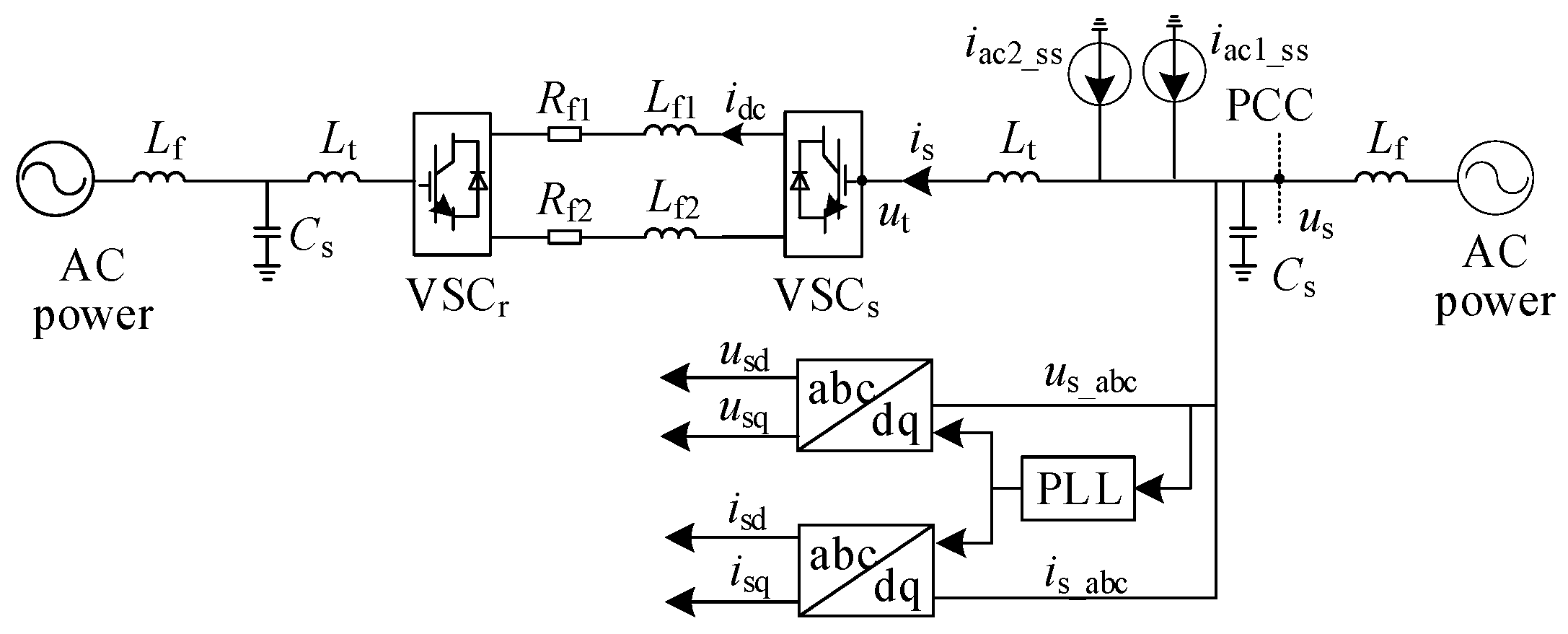


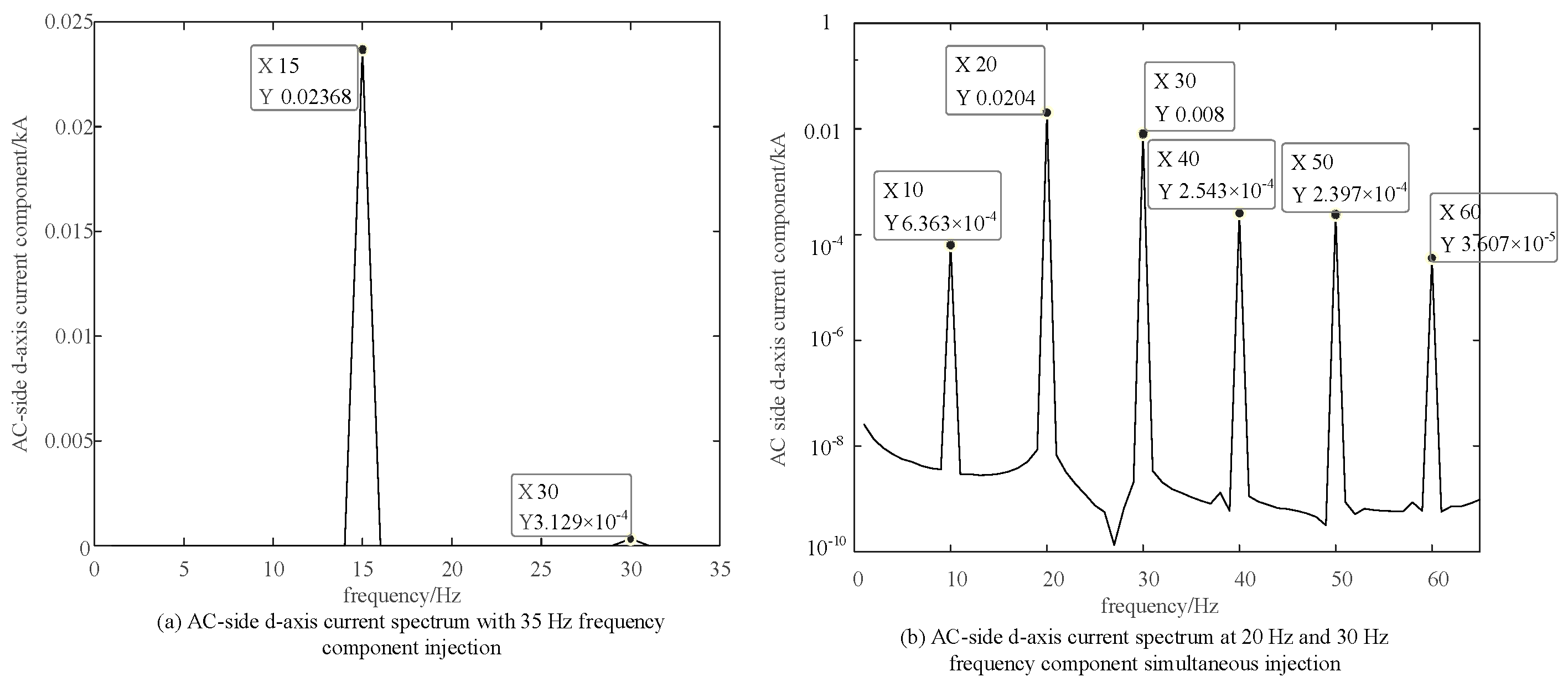

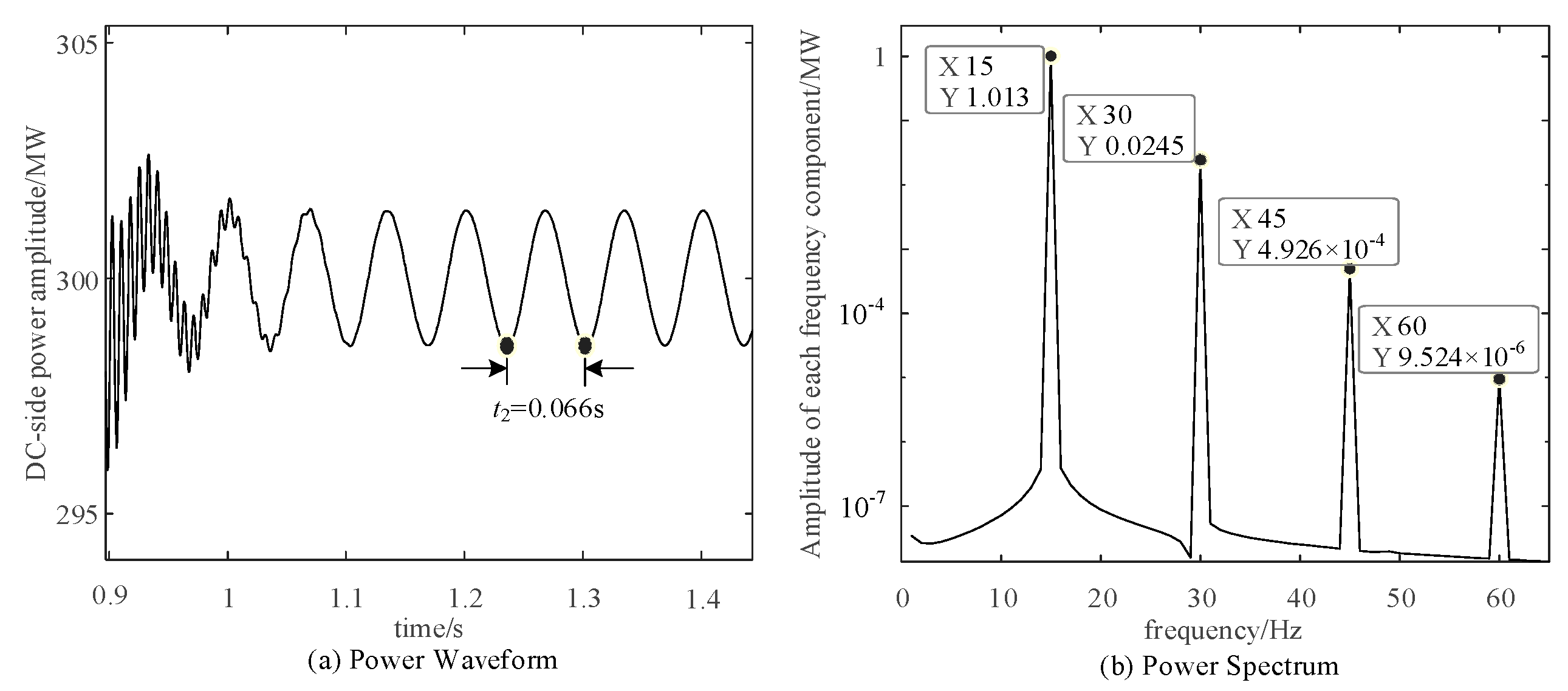

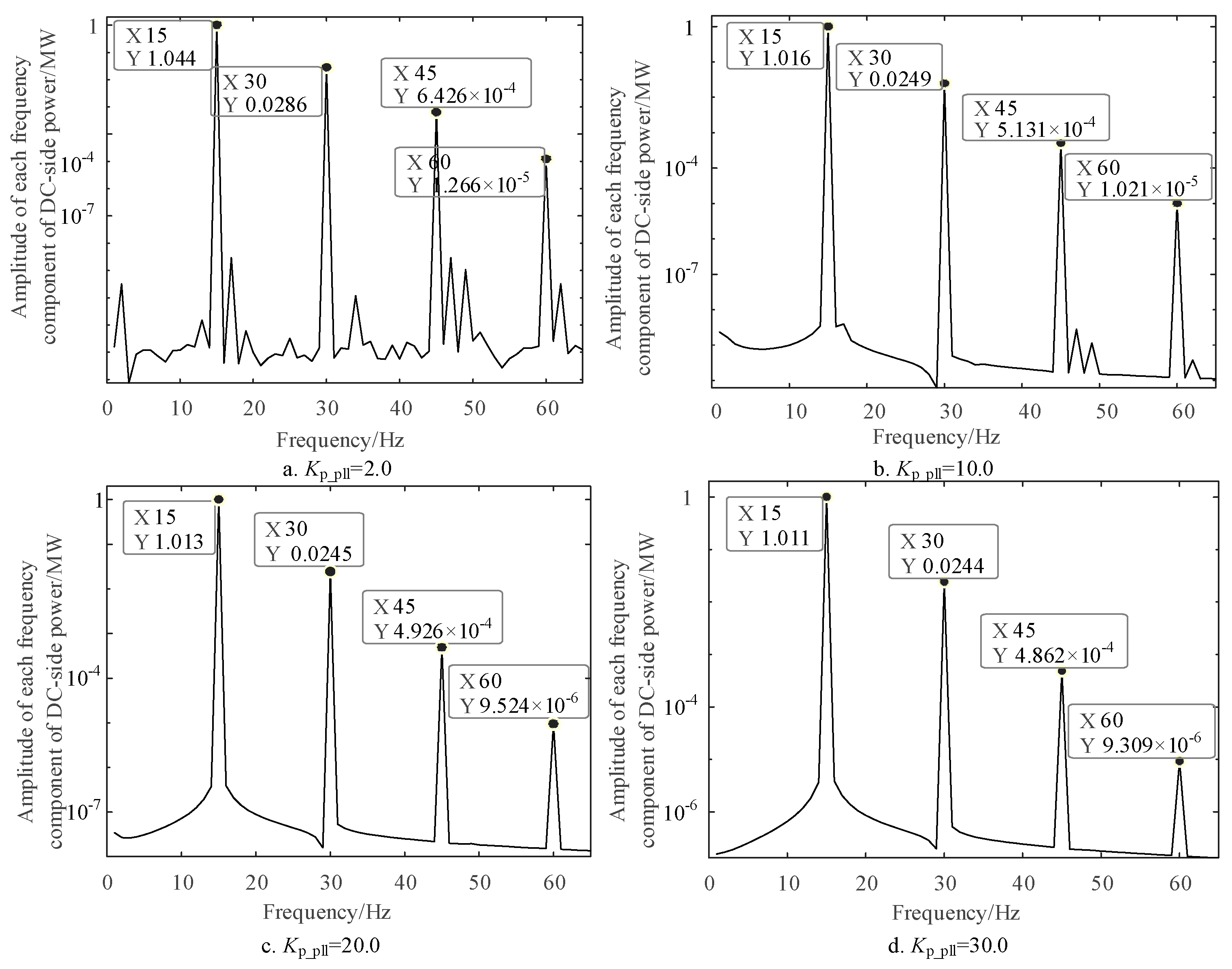

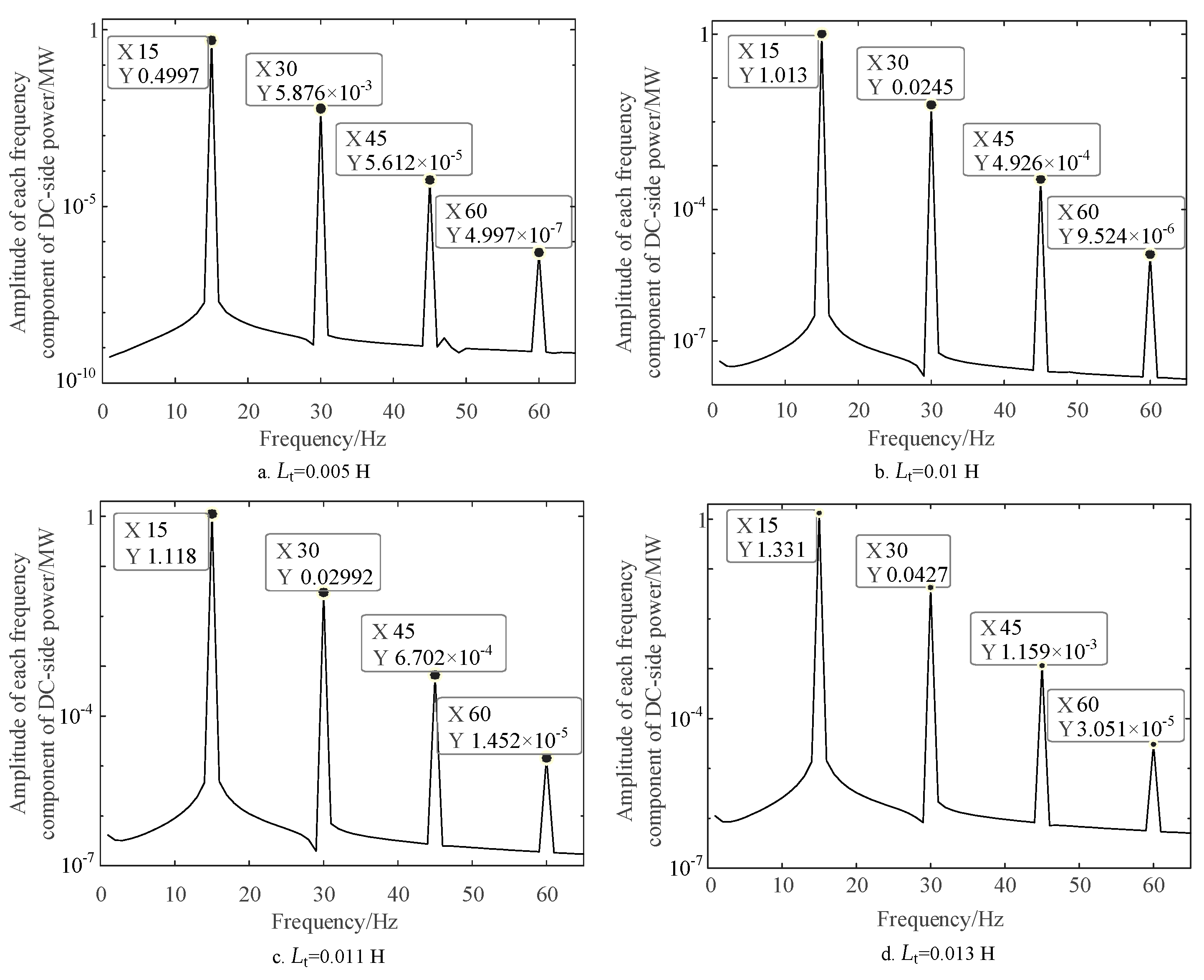
| AC-Side Current Frequency Component | DC-Side Power Frequency Component |
|---|---|
| ω0 − ωac1 | ω0 − ωac1 2ω0 − 2ωac1 |
| 2ω0 − 2ωac1 | 3ω0 − 3ωac1 4ω0 − 4ωac1 |
| AC-Side Current Frequency Component | DC-Side Power Frequency Component |
|---|---|
| ω0 − ωac1 2ω0 − 2ωac1 | ω0 − ωac1 2ω0 − 2ωac1 3ω0 − 3ωac1 4ω0 − 4ωac1 |
| ω0 − ωac2 2ω0 − 2ωac2 | ω0 − ωac2 2ω0 − 2ωac2 3ω0 − 3ωac2 4ω0 − 4ωac2 |
| ωac1 − ωac2 | ωac1 − ωac2 2ωac1 − 2ωac2 ω0 − 2ωac2 + ωac1 ω0 − 2ωac1 + ωac2 2ω0 − ωac1 − ωac2 2ω0 − 3ωac1 + ωac2 |
| 2ω0 − ωac1 − ωac2 | 2ω0 + ωac1 − 3ωac2 3ω0 − ωac1 − 2ωac2 3ω0 − 2ωac1 − ωac2 4ω0 − 2ωac1 − 2ωac2 4ω0 − 3ωac1 − ωac2 4ω0 − ωac1 − 3ωac2 |
| Parameters | Value |
|---|---|
| AC-side Voltage/kV | 110 |
| Filter Inductor Lt/H | 0.01 |
| Shunt capacitor Cs/μF | 5 |
| Kp_pll, Ki_pll | 20, 50 |
| D-axis inner loop proportional and integral parameters | 5.28, 10,000 |
| Q-axis inner loop proportional and integral parameters | 5.28, 10,000 |
| Active power reference Pref/MW | 300 |
| Reactive power reference Qref/Mvar | 0 |
| PLL Integral Coefficient (Ki_pll) | DC-Side Power Amplitude (15 Hz)/MW | DC-Side Power Amplitude (30 Hz)/MW | DC-Side Power Amplitude (45 Hz)/MW | DC-Side Power Amplitude (60 Hz)/MW |
|---|---|---|---|---|
| 25 | 1.01255 | 0.0244788 | 4.92673 × 10−4 | 9.53981 × 10−6 |
| 40 | 1.01257 | 0.0244808 | 4.92621 × 10−4 | 9.52625 × 10−6 |
| 50 | 1.01258 | 0.0244814 | 4.92623 × 10−4 | 9.52372 × 10−6 |
| 100 | 1.01260 | 0.0244836 | 4.92747 × 10−4 | 9.52804 × 10−6 |
| d Axis Current Inner Loop Proportional Coefficient (Kpd) | DC-Side Power Amplitude (15 Hz)/MW | DC-Side Power Amplitude (30 Hz)/MW | DC-Side Power Amplitude (45 Hz)/MW | DC-Side Power Amplitude (60 Hz)/MW |
|---|---|---|---|---|
| 5.08 | 1.01237 | 0.0244709 | 4.92113 × 10−4 | 9.50216 × 10−6 |
| 5.18 | 1.01247 | 0.0244761 | 4.92368 × 10−4 | 9.51295 × 10−6 |
| 5.28 | 1.01258 | 0.0244814 | 4.92623 × 10−4 | 9.52372 × 10−6 |
| 5.38 | 1.01237 | 0.0244709 | 4.92113 × 10−4 | 9.50216 × 10−6 |
| q Axis Current Inner Loop Proportional Coefficient (Kpq) | DC-Side Power Amplitude (15 Hz)/MW | DC-Side Power Amplitude (30 Hz)/MW | DC-Side Power Amplitude (45 Hz)/MW | DC-Side Power Amplitude (60 Hz)/MW |
|---|---|---|---|---|
| 1.5 | 1.01256 | 0.0244803 | 4.92793 × 10−4 | 9.55026 × 10−6 |
| 2.0 | 1.01257 | 0.0244807 | 4.92748 × 10−4 | 9.5422 × 10−6 |
| 2.5 | 1.01258 | 0.0244814 | 4.92623 × 10−4 | 9.52372 × 10−6 |
| 3.0 | 1.01258 | 0.0244816 | 4.92639 × 10−4 | 9.52469 × 10−6 |
| q Axis Current Inner Loop Integral Coefficient (Kiq) | DC-Side Power Amplitude (15 Hz)/MW | DC-Side Power Amplitude (30 Hz)/MW | DC-Side Power Amplitude (45 Hz)/MW | DC-Side Power Amplitude (60 Hz)/MW |
|---|---|---|---|---|
| 1000 | 1.0139 | 0.0247099 | 5.0705 × 10−4 | 1.00151 × 10−5 |
| 5000 | 1.01264 | 0.0244927 | 4.93534 × 10−4 | 9.58107 × 10−6 |
| 10,000 | 1.01258 | 0.0244814 | 4.92623 × 10−4 | 9.52372 × 10−6 |
| 20,000 | 1.01254 | 0.0244763 | 4.92551 × 10−4 | 9.54171 × 10−6 |
| AC Grid Inductance (Lf) | DC-Side Power Amplitude (15 Hz)/MW | DC-Side Power Amplitude (30 Hz)/MW | DC-Side Power Amplitude (45 Hz)/MW | DC-Side Power Amplitude (60 Hz)/MW |
|---|---|---|---|---|
| 0.004 H | 0.3990 | 0.0037 | 2.829 × 10−5 | 1.985 × 10−7 |
| 0.007 H | 0.7027 | 0.0117 | 1.593 × 10−4 | 2.050 × 10−6 |
| Active Power Reference Value (Pref) | DC-Side Power Amplitude (15 Hz)/MW | DC-Side Power Amplitude (30 Hz)/MW | DC-Side Power Amplitude (45 Hz)/MW | DC-Side Power Amplitude (60 Hz)/MW |
|---|---|---|---|---|
| 100 MW | 0.0667 | 0.0335 | 0.0225 | 0.017 |
| 200 MW | 0.1291 | 0.0647 | 0.0434 | 0.0329 |
Disclaimer/Publisher’s Note: The statements, opinions and data contained in all publications are solely those of the individual author(s) and contributor(s) and not of MDPI and/or the editor(s). MDPI and/or the editor(s) disclaim responsibility for any injury to people or property resulting from any ideas, methods, instructions or products referred to in the content. |
© 2024 by the authors. Licensee MDPI, Basel, Switzerland. This article is an open access article distributed under the terms and conditions of the Creative Commons Attribution (CC BY) license (https://creativecommons.org/licenses/by/4.0/).
Share and Cite
Bin, Z.; Feng, X.; Miao, Z.; Kong, X.; Li, P.; Shao, B. Frequency Characteristic Analysis of the VSC-HVDC DC Oscillating Power under AC Sub-Synchronous Disturbances. Electronics 2024, 13, 3445. https://doi.org/10.3390/electronics13173445
Bin Z, Feng X, Miao Z, Kong X, Li P, Shao B. Frequency Characteristic Analysis of the VSC-HVDC DC Oscillating Power under AC Sub-Synchronous Disturbances. Electronics. 2024; 13(17):3445. https://doi.org/10.3390/electronics13173445
Chicago/Turabian StyleBin, Zijun, Xuan Feng, Zilong Miao, Xiangping Kong, Peng Li, and Bingbing Shao. 2024. "Frequency Characteristic Analysis of the VSC-HVDC DC Oscillating Power under AC Sub-Synchronous Disturbances" Electronics 13, no. 17: 3445. https://doi.org/10.3390/electronics13173445





